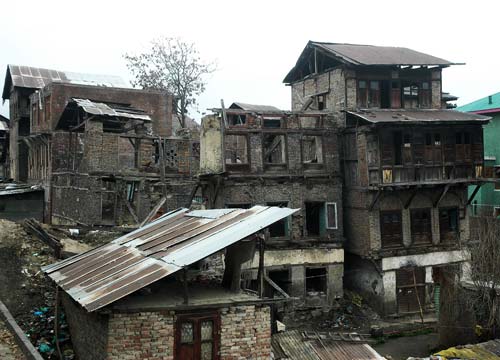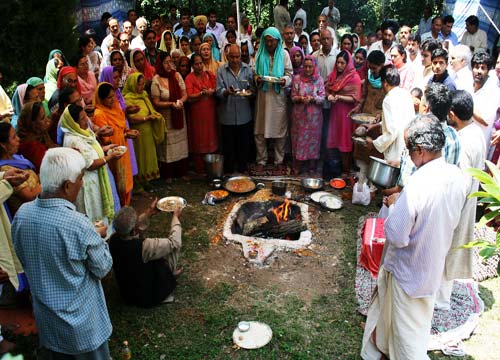At the peak of insurgency against Indian rule in Kashmir valley when Pandit community became easy targets of unidentified gunmen, in many cases separatist militants, a number of Pandits braved the threats, decided to stay and are happily living in Kashmir, Bilal Handoo reports.

On a dark night in 1991, when militancy was at its peak in Kashmir valley, unidentified men set fire to Pandit houses in old city’s Habba Kadal area which was largely inhabited by Hindu community. The target, it seemed, was chosen carefully to send a message to the Pandits, that they must leave the valley.
“Soon after that,” says Abdul Khaliq, whose shop stands adjacent to the gutted houses, “Three members of a Pandit family were killed by some unknown persons.” While the gunmen, who remain unidentified till now, disappeared, the rumors that the Kashmiri militants were behind the killings started doing rounds.
“Incidents like these strengthened the perceptions among Pandits that they were being carefully targeted. It had its impact. After the killings, the Pandits migrated en masse and the entire Habba Kadal locality was deserted in the initial years. It looked like a haunted place,” he said.
Over the last 23 years of conflict in Kashmir, there is not even a single person who has not been affected by war, directly or indirectly but the signs of turmoil are more palpable in Habba Kadal area which was once vibrant and full of life and now remains largely deserted due to a large number of ruins and rubbles of Pandit houses.
Official records and conversations with the Muslims inhabitants of Habba Kadal reveal that there were 80-90 percent Pandit houses before 90’s when Kashmir erupted in violence against Indian rule. Given the level of threat faced by the community and a crippled government which was unable to secure them, a majority of them left their houses and migrated to Jammu.
But not everyone followed the footsteps of majority. A few mustered the courage to stay back in spite of threats and insecurity surrounding them. Kosha Puri was one of them. Narrow lanes of Habba Kadal’s Chinkral mohalla lead to the dilapidated house of Kosha, an aged mother of two.
Carrying a smile on her parched face, Kosha, whose husband passed away in 2010, is reluctant to narrate her journey of the last two decades. “It is better not to talk about it,” she said in a choked voice. The first floor of her house is locked. It belongs to her brother-in-law who has left the valley.
“When my husband died, violent protests were happening on the streets of Kashmir. But my Muslim neighbors helped me in the cremation of my husband,” she said with a tone of gratitude.
Age has taken its toll on Kosha. With a drooping figure, she walks gingerly. But that doesn’t stop her to pay obeisance at the local temple daily, a few kilometers away from her house. “My strong devotion to almighty has kept me alive through all these years,” says Kosha, who is currently working as a peon at a local government-run school.
Bhagvaan Gopinath Ashram in Kharyar area of Habba Kadal supports her family by offering them regular financial help. Her daughter is presently pursuing a computer course while her son is a grocer.
A few households away in Bhan Mohalla of Habba Kadal lives another Pandit lady, Meena Khoda. She also decided to stay in Kashmir when a majority of Hindu inhabitants of Kashmir decided to leave. She is presently living in her ancestral house. “This house was locked before 90’s. But as the situation took an ugly turn, we shifted back here from Srinagar’s Indira Nagar,” said Meena who lives here with her husband. The family runs a shawl business in Kashmir which was also a reason that they stayed back in Kashmir.
Meena, who is the sister-in-law of the former DG, J&K police, Kuldeep Khoda, is all praises for her Muslim neighbors who helped her during the years of violence. “I was never let down by my neighbors. It never struck me that I should also leave the place,” she said.
“Habba Kadal used to have an aura of its own,” says Ghulam Qadir Dar who was one of the few Muslim shopkeepers living in Bhan Mohalla when Pandits lived here. “Ever since the mass migration of Pandit community, this place has been reduced to ghost lanes and desolated houses,” he told Kashmir Life.
Qadir’s remarks find resonance among the scored of desolated Pandit houses. While some of Pandits sold their properties to the Muslims in Kashmir, other didn’t. Although most of the houses have been rebuilt by the new property owners, a plenty of them are still standing in frail conditions. “Most of the Pandits sold their properties. As far as the remaining structures are concerned, no one knows where their owners are,” Qadir says with a tinge of sadness in his voice.
A few steps ahead of Bhan Mohalla lives another shopkeeper, Abdul Khaliq. Sitting in his old wooden grocery shop and holding a Kangri (a fire pot) inside his pheran (a traditional Kashmiri winter attire), he looks quiet and absorbed. He has been witness to an era in Habba Kadal when it was buzzing with life.

“Nowhere in old city was life as happening as it was here. But nothing remains constant in life,” a visibly nostalgic Khaliq says. He recalled the dark night in 1991 when some Pandit houses were torched. Soon after that, Habba Kadal’s spirit ceased to exist and the life came to a grinding halt. Curfew and siege over the area would not allow shopkeepers to throw their shops open for days together, as per the accounts of shopkeepers here. But once siege used to get over from the place, customers would disappoint the traders. “As long as pandits were around, I along with other shopkeepers used to earn handsome as they had better purchasing power, but soon after they left, trade here took a huge dip,” said a grocer Mohammad Sultan who runs his shop since 1967 here.
As the panic to move towards safer places gripped the Hindu community, most of them left their properties in a hurry hoping that they would come back as soon as normalcy returned to Kashmir valley. Their houses remained under the vigil of government forces for some time till the forces conducted a search operation in 1991 which lasted for three days. “In order to hunt down the militants, the government forces broke the locks of Pandit houses. Once the operation was over, some miscreants took the advantage of open houses and thereby looted the houses,” Qadir says.
But not everyone left their properties at the mercy of uncertain situation then. Chaman Lal Mattu, a retired official from telecom department stayed back. He claims that he was on the hit-list of militants, “But I never succumbed to the pressure tactics and remained grounded in Kashmir.” When Kashmir Life asked him why Pandits became targets, he said, “It was out of disillusion basically. The impression given at that point of time was that Pandits are police informers or working for IB (Intelligence Bureau) which wasn’t the reality.”
He says his two friends lost their lives due to this perception prevailing among people. One of his friends, B Saraf , who went to see his tailor one evening, was found killed near the old Habba Kadal bridge, “Another friend, Handu, was shot dead at Chota Bazaar in old city. Both of them met very unfortunate end like many innocent Muslims at that time,” said Mattu in the lawns of Bhagvaan Gopinath Ashram where he regularly offers prayers twice a day.
Mattu once had an altercation with a militant whose telephone connection he had terminated due to unpaid telephone bill. “The next day he came to my office and asked me to resume his connection. When I refused, he dared me to come out of the security at my office and then talk. As I followed him, he pointed a gun at me and asked me to change my stand or face the music. But I told him that my life was controlled by the will of almighty and that no one could snatch that from me,” he says.
Mattu was left unharmed by the ilitant who also paid his telephone bill to resume his connection. “Although the killings of some Pandits did break the resolve of some members of our community but leaving their homes was never at the back of their minds until a huge procession on January 18, 1990 altered their mindset. It was the same procession where slogans for Islamic Kashmir were raised. This became a turning point which catalyzed the mass migration of Pandits from Kashmir valley,” he says.
His house in Kharyar area of Habba Kadal was engulfed in a blaze in 1991 along with 55 other Pandit houses. Before the fire incident, most of them were being vacated to safer places owing to fear psychosis prevailing in the community, “Such was the threat perception that my elder brother who used to live in the upper storey of our house, left in midnight with his family without even informing me,” recalls Mattu.
“I belong to this place,” Kosha says. “Kashmir is my home. Why should I have left my home?”















